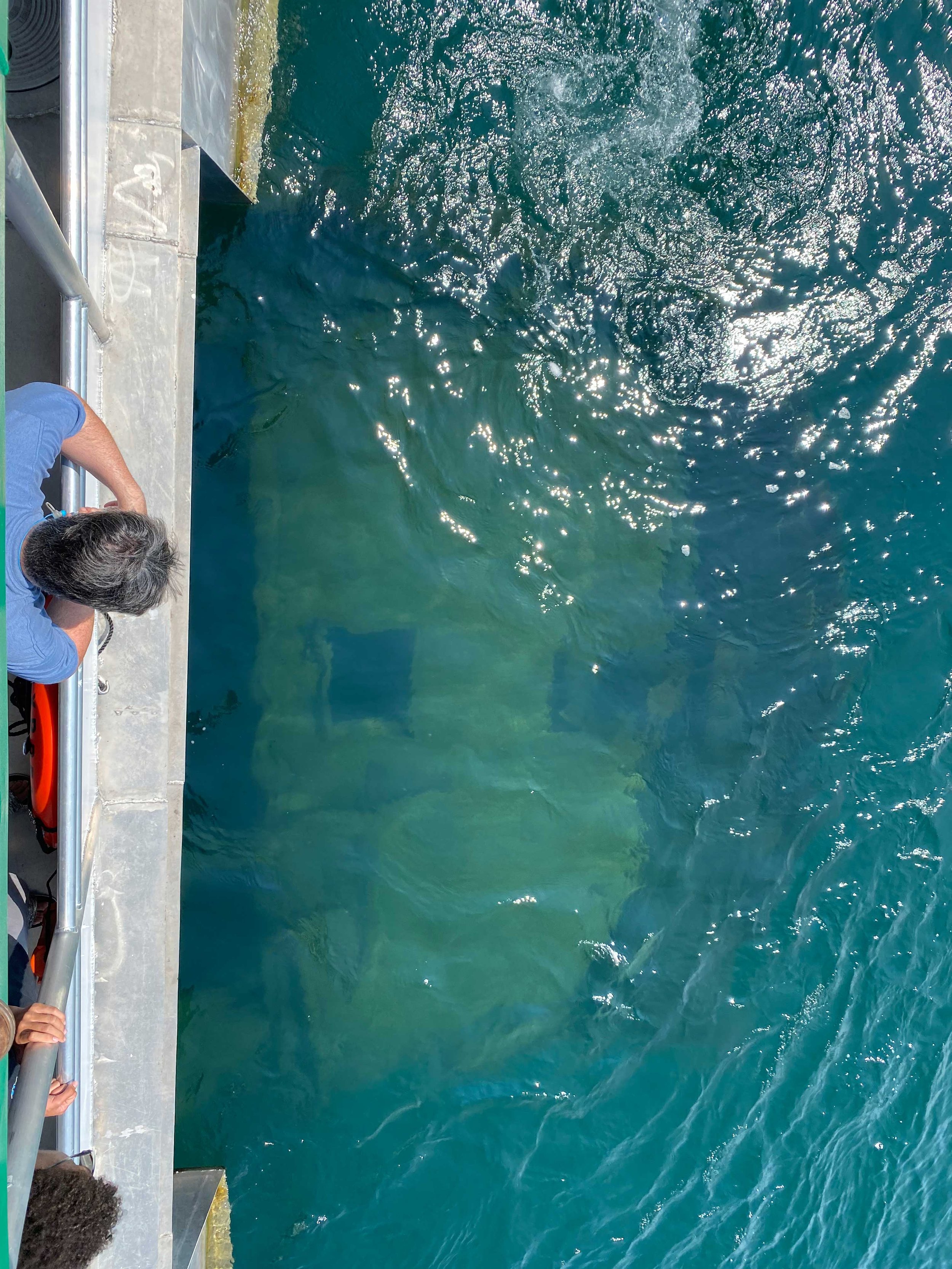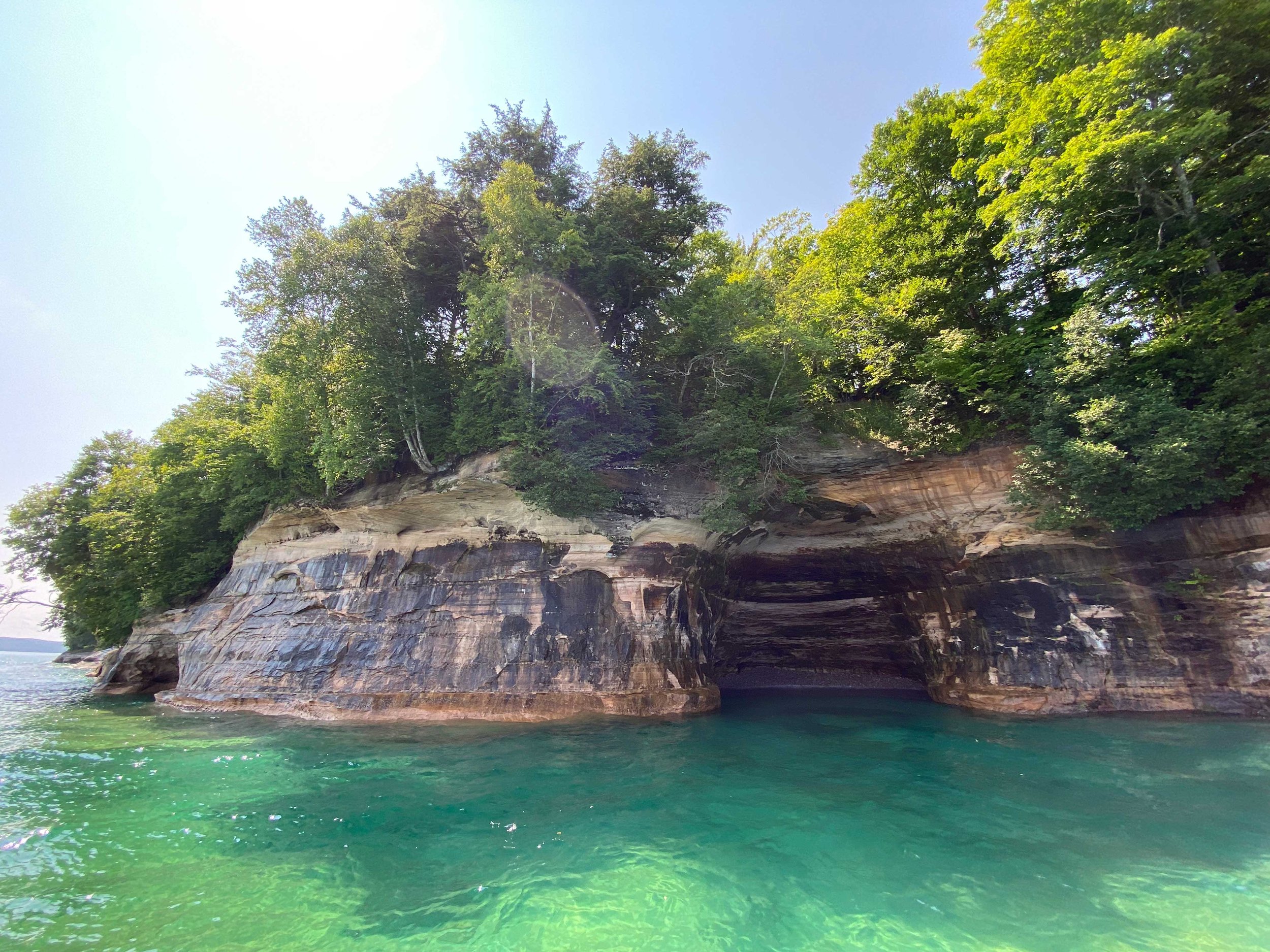Shipwrecks of Lake Superior
Glass-Bottom Boat Tour
August 10th, 2021
The deep wail of a horn bellows out from the glass-bottomed boat docked on the shores of Lake Superior. Her name is Miss Munising. The sound reverberates through my belly and stings my ears to tell me that it’s time to go. “Welcome aboard,” Captain John greets us with a friendly smile, as my love and I step into the vessel.
The captain’s voice is masked in static over the intercom as he addresses us from the wheelhouse, where he gently directs the ship away from the dock. We are seated on benches that line the walls of the lower deck, leaving space in the middle for the main attraction: deep-set windows that reveal the secrets of the lake. Neon light reflects on the black metal siding of the pit down to the view ports, as emerald water—littered with hazy bits of driftwood—glides by below the pane.
Suddenly, the smooth-sailing scene evolves into a torrent of bubbles as the boat, roaring and rumbling, picks up speed. It sends a shock wave through the metal seats below our bottoms. I turn my attention to the open window beside me, feeling the hot sun burn my face, which is equally pacified by a breeze. The air carries scents of fish and metal. Outside, I see glistening waters of robin’s egg blue, set against rough green hills speckled with white gulls. Nearby, a fisherman dips his foot into the crystal clear water from the edge of his pole-lined boat.
In a moment, the lake turns into an ocean as the bay opens up into an endless horizon. For a time, all that surrounds us is water, until our captain brings us to a slow taxi in a nearby inlet. Standing, I lean against the railing and watch the transparent floor below me with bated breath. Bubbles settle like washing machine suds against the glass, and I tip a little on my sea legs. Veins of sunlight penetrate the turquoise deep. Then, suddenly, the curved bow of a ship slices into view: a ship directly below our own. She is drowned, frozen in a moment of tragic time, her pain preserved to indulge the morbid curiosity of my eyes.
The shadowy shape of The Bermuda eases past as our own vessel floats over it. The deceased ship reveals a square metal hatch, a broken mast of pale tan-green, and a gaping mouth of toothy-edged floorboards. I expect to see a village of aquatic life living amidst its ruin, but no seaweed or barnacles coat her sides. No eels or fish weave in and out of her decaying wooden ribs. The salt-free waters of the lake are too cold. She sleeps in isolation, restrained from decay by tourism exploits, forced to remain forever in death like a ghost locked out of Heaven.
Ascending to the upper deck of Miss Munising, I listen to The Bermuda’s lamentable story told by Captain John, and watch regretfully as we leave her and the memory of her crew to view the next victim of Lake Superior. The Bermuda’s broken timber, coated in a soft layer of algae, is a visible shadow looming below the glistening water’s surface. It is so clear that, as we approach the next wreck, we can see where the sand bar drops suddenly into a navy blue recess: the reef that took the life of The Herman Hettler.
As we drift over this next ship, gaping holes tell tales of turmoil. Surrounding its wreckage are patches of black where iron ore was dumped for buoyancy to try to save the ship during the snowstorm that sank it. Amid the rubble, we spot signs of life long gone: an anchor, a cast-iron claw-foot tub, and the seat of a porcelain throne. I can imagine the fear, the darkness, the cold, as one little miscalculation destroyed everything.
My present reality, however, drastically contrasts the scene. As we make our way back to the docks, and my companion and I return to the upper deck, I am surrounded with summer sunshine and beauty. Here, the wind wicks the sweat from my body through the fabric of my shirt, and gently massages my face. A bald eagle leaps from an evergreen near an old wooden lighthouse. We pass Pictured Rocks, where we kayaked the day before, and spot other orange and yellow kayaks gliding below the trees, their paddles fluttering like butterfly wings.
Life does not halt for the life halted. It carries on and carries with it the memory of those lost, until that memory, too, is parted from the world.
Experienced During
Michigan’s Upper Peninsula
Highlights
Bermuda Shipwreck
Grand Island East Channel Light
Pictured Rocks
The Herman H. Hettler
















